By Muhammad Sohaib1, Syeda Zainab Kanwal Bokhari2, Kashif Ur Rehman Khalil3, Baber Awan4, Nazim Hameed5, Yasir Hakim6
- University of Bradford, Bradford, United Kingdom.
- Department of Pathology, Hayatabad Medical Complex, Peshawar, Pakistan.
- Department of Community Medicine, Khyber Medical College, Pakistan.
- Department of Community Medicine, Pak International Medical College, Peshawar, Pakistan.
- Department of Community Medicine, Gajju Khan Medical College, Peshawar, Pakistan.
- Naseer Teaching Hospital, Peshawar, Pakistan.
DOI: https://doi.org/10.36283/PJMD12-2/007
How to cite: Sohaib M, Bokhari SZK, Khalil KUR, Awan B, Hameed N, Hakim Y. New Risk Factors Defined for Anemia Among School-Going Children in Peshawar, Pakistan. Pak J Med Dent. 2022;12(2): 36-42. doi: 10.36283/PJMD12-2/007
Background: Anemia, “a hidden hunger” is among one the major nutritional public health problems across the globe affecting both developed and developing countries. In children, it results in impaired cognitive performance, behavioral, linguistic development and scholastic achievement. The study aimed to estimate the frequency and new risk factors of anemia in school-going children of Peshawar.
Methods: A cross-sectional study was conducted from February 2020 to January 2022. A sample of 240 children between the ages of 5-15 years from eight different schools, were selected. The data was analyzed using SPSS version 20 for windows. Chi-square test was used to see association between different variables. p≤0.05 was taken as a minimum level of significance.
Results: Among a total of 240 school-going children, 93 (38.75%) were anemic and 147 (61.2%) were non-anemic. The anemia prevalence was higher in female children and younger age groups. The percentage of anemic children was significantly higher who don’t take nutritional supplements (19.7%) compared to those who do (47.5%) (p˂0.001). The anemic children with worm infestation history, were significantly higher (51.6%) in number compared to (25.4%) without infestation (p˂0.001). Majority (66.6%) of children from lower socioeconomic groups were anemic (p˂0.001).
Conclusion: Children, school-going, and vegetarian were found significantly anemic (p<0.001). Female children were more prone to anemia than male children.
Keywords: Anemia, School Going Children, Pakistan.
Anemia is defined as a condition in which the quantity of hemoglobin in blood is below than normal level due to deficiency of essential nutrients, excessive blood loss, worms’ infestation and other hemolytic diseases1. According to WHO, cut-off values for anemia include a level of blood hemoglobin less than 11 g/dL for females and <12 g/dL for males2,3.
Worldwide anemia is the most common issue, especially in a pediatric age group with an estimated prevalence of 43%. An estimated 1.62 billion people have affected annually throughout the globe. It is estimated that 30 to 50% of anemia is caused due to deficiency of iron in blood4. According to the Pakistan National Nutritional survey, in 2018 anemia among children is 53.7% (54.2% in boys and 53.1% in girls)5. Anemia is caused due to multifactorial reasons. Some of the important risk factors in the general population include; poor dietary habits, worm infestations and also sociodemographic factors like poverty and lack of education6.
Anemia may occur at all stages of life but pregnant women and young children are more vulnerable due to their rapid growth and high iron demand7. One of the major reasons for anemia in children is a replacement of breast milk with formula milk which does not contain enough iron, vitamin B12 and folic acid8. The Consequences of anemia especially in school-age children are numerous including low IQ level, fatigue and poor performance academics9,10.
Although anemia remains a serious public health concern, a limited number of studies are done to assess the levels of anemia in school-aged children. This study aimed to assess the prevalence of anemia in both rural and urban areas of Peshawar, Khyber Pakhtunkhwa Pakistan. This study is also important because it identified some novel risk factors that need to be addressed by policymakers. By assessment of burden, the distribution, etiology and contributory factors of anemia can be identified in school-going children, an important tool for adopting appropriate preventive measures.
A cross-sectional study was carried out in schools of both rural and urban areas of district Peshawar, Khyber Pakhtunkhwa, Pakistan to measure the prevalence of anemia among school-going children and their associated determinants. The period of study was from February 2020 to January 2022. Ethical approval was taken from the institutional ethical committee. Consent was taken from the parents/guardians of the children. Students and school staff were assured of the confidentiality of all information. Children of sex, studying from class 1 to class 10 between 5-15 years of age and willing to participate were selected. Children with a history of any systemic illness or with any known drug allergy were excluded from the study. The net sample size for this study of 240 students was determined by using single population formula. The prevalence of anemia from the previous study (50%) was considered and the margin of error was kept at 5% with a 95% confidence interval. The sample size included a total of 30 students from each school and a total of eight schools were included. Data was collected by cluster random sampling method. Two towns were selected and then in each town, two union councils were selected. In each Union Council, a school was randomly selected and, in each school, every eight students were selected according to roll number.
A preliminary visit was done to each school before the data collection and the teachers were instructed to obtain consent from the parents or guardians. Written permission from the principal of each school was taken. The information regarding socio-economic status, nutritional status and dietary habits were collected with the help of junior residents and school teachers by a pre-tested structured questionnaire. For the Hb level, a complete medical examination was done and then blood samples were taken by a lab technician from each subject and submitted to a laboratory. The result of each Hb level was then filled in a questionnaire of that specific subject.
For operationalization of the variable, the cut-off values according to recent WHO criteria for anemia were considered. Hb levels <11 g/dL for girls and <12 g/dL for boys were labeled as anemic while for grading of anemia, children with Hb level 11-11.4 gm/dl were labeled as mild, moderate with Hb level 8-10.9 gm/dl and severe with Hb < 8 gm/dl. All the results were recorded and analyzed by Statistical Package for Social Sciences (SPSS) version 24 for windows. Data cleaning was done to check for frequency, accuracy, consistency and missing values. Any errors identified were rectified. Descriptive statistics mean (S.D) or proportion was recorded for age and Hb level. While for categorical variables Chi-square test was used for assessment. p ≤ 0.05 was taken as a minimum level of significance.
Out of 240 school children who participated in this study, 57.5% were males with a mean age of (10.21 ± 1.89) years while the remaining 42.5% were female children with a mean age of (11.01 ± 2.56) years. Among 240 school-going children, 93 (38.75%) were found anemic and 147 (61.2%) were non-anemic (Figure 1). The sociodemographic characteristics of the students are shown in Table 1.
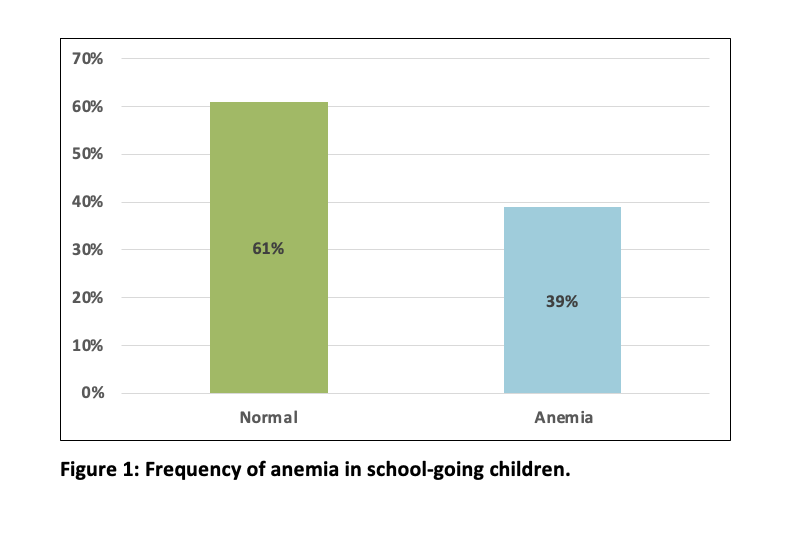
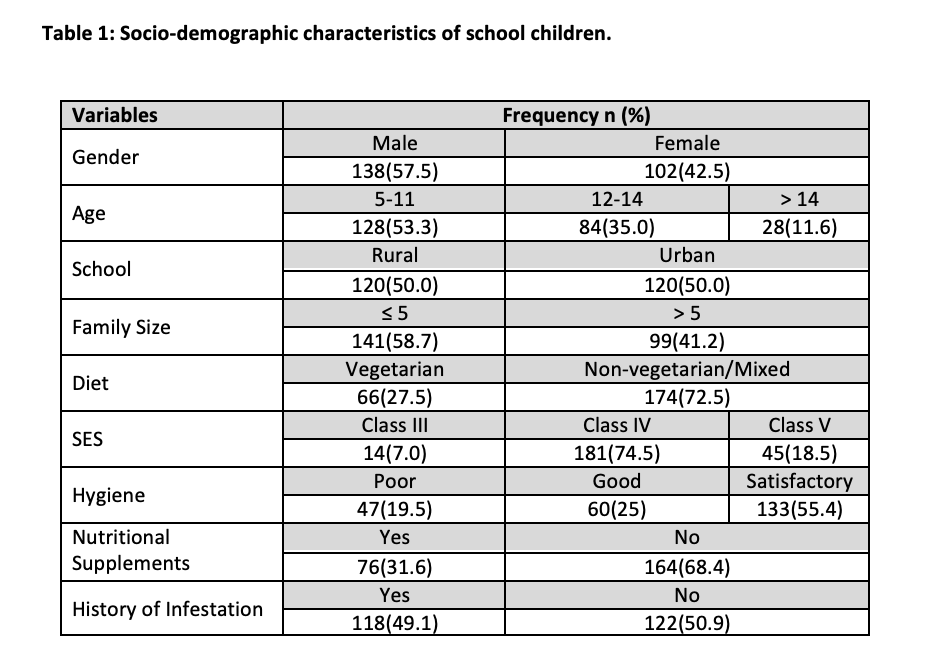
Among a total of 93 anemic children mild anemia was found to be present in 33 (13.7%) of children (Table 2) while moderate and severe anemia was reported in 48 children (20%) and 12 (5%) children respectively. The lower age group children (5-11) have moderate anemia while increasing age showed mild anemia (Table 3). Anemia was seen in 34.7% of males and 44.2% of females. The prevalence of anemia was more in girls than in boys (p=0.171) (Table 4).
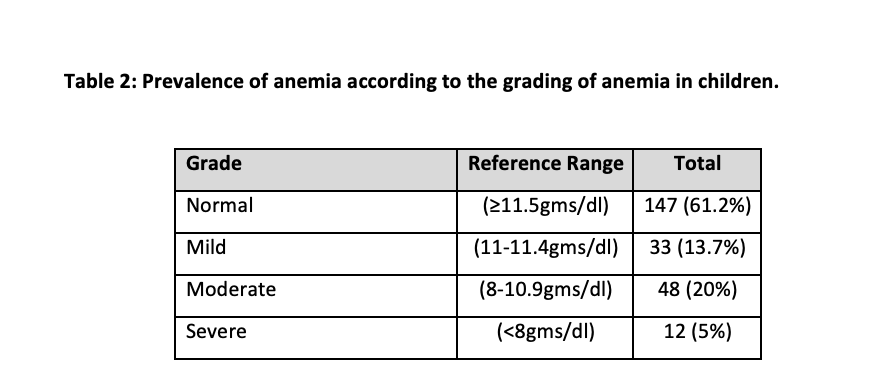
Concerning the location, the rural areas children were more anemic i.e., 45.8% compared to the urban parts comprising 31.6% anemic patients with p = 0.018. Less proportion of anemia was reported in families having less than 5 members (36.1%) in comparison to those having more than 5 members. Regarding dietary habits (57.6%) vegetarian children were anemic (p=0.021). Most (66.6%) of the children belonging to lower socioeconomic groups (lower class) were anemic and highly significant (p˂0.001). Children having poor hygiene had the most anemia percentage of 49.6% with satisfactory hygiene children having only 14.9% of anemia proportion (p˂0.05). The percent of anemic children who takes nutritional supplements was (19.7%) and (47.5%) do not take nutritional supplements with a highly significant (p˂0.001) value while, the percent of anemic children who had a history of worm infestation, was (51.6%) and (25.4%) showed no history of worm infestation (p˂0.001).
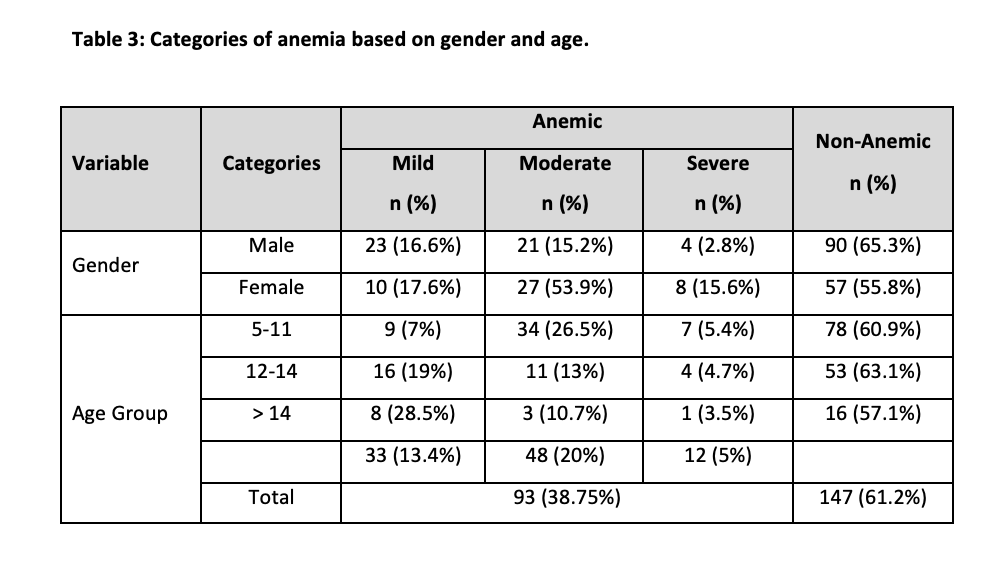
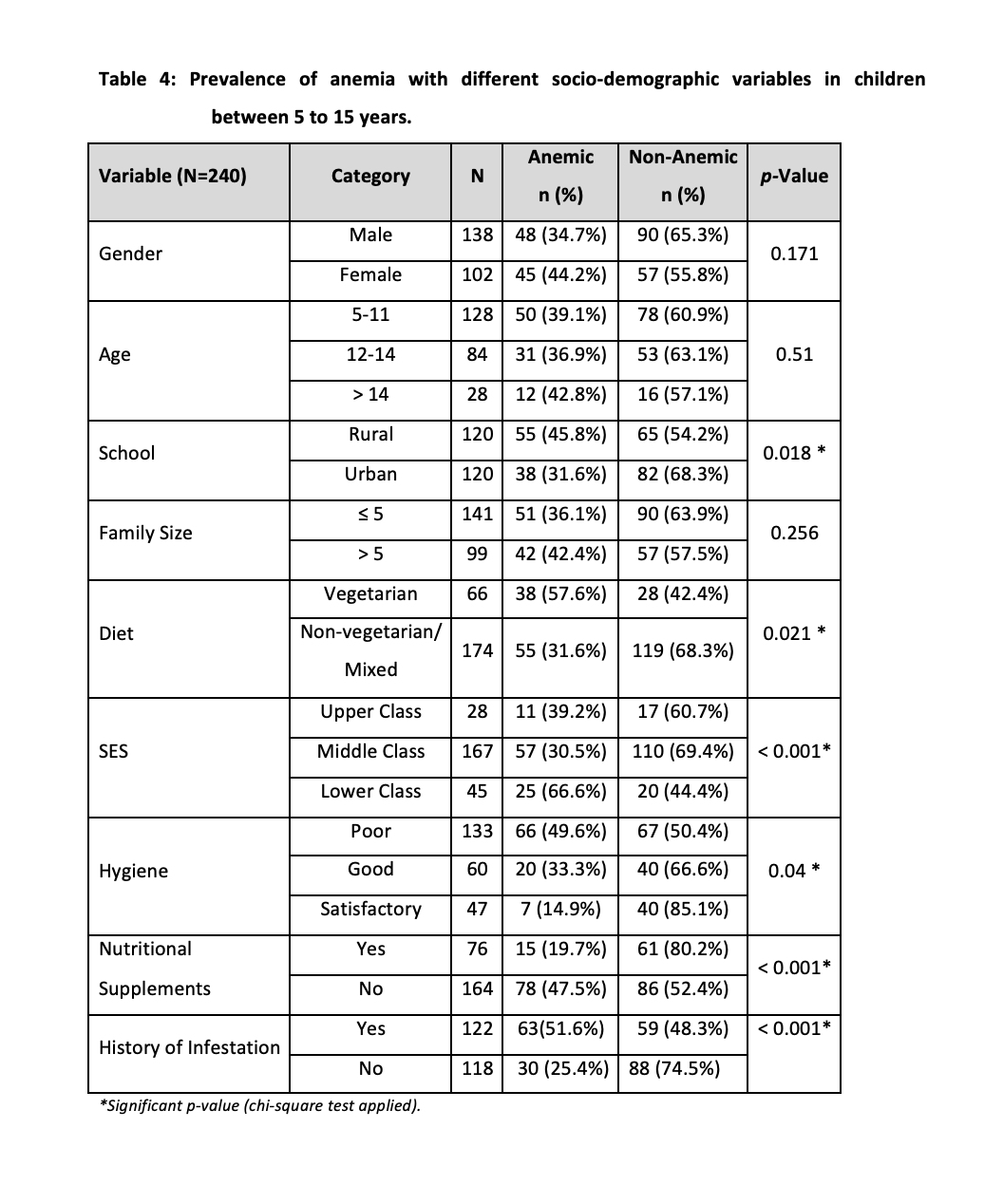
The exact prevalence of anemia in school-going children varies from location to location and study to study but anemia is accepted to be a serious issue in the school-going children age groups. Our study showed that among 93 anemic children, mild anemia was found to be present in 33 (13.7%) of children while moderate and severe anemia was reported in 48 children (20%) and 12 (5%) children respectively.
The current study findings are following the results of different other studies that are done in developing countries. The overall prevalence of anemia among participants according to our study was 38.7%. The frequency of anemia in our study is remarkably similar with a rate of 38% in Pakistan and 34.0% in district Karak11. While it is significantly higher than 25.4% globally and remarkably higher than 3.2% in developing countries. The percentage of anemia in children of Africa was 60 percent, in Latin America at 46%, in East Mediterranean at (63%), in South Asia at (49%) and in North America at only 7% 12.
A study conducted by Gutema et al. in South East Ethiopia showed the prevalence of anemia at 23.66%. Mild anemia was detected in 73.81% of the sampled children and moderate and severe anemia was detected in 25% and 1.19% of children, respectively. Low socio-economic status and intestinal worms were the associated factors that were detected in their study13. Another study conducted by Birhanu et al. identified 33.9% of anemia among 442 school-going children in Ethiopia. Risk factors identified in their study were illiteracy of mothers, Parasitic and malarial infections14. Our study showed 38% of anemia in school-going children and risk factors identified included rural areas, poor diet and a history of worm infestations.
Iron deficiency is the most common form of anemia in school-going children. Iron deficiency anemia is associated with low IQ levels in school children15,16. Agarwal conducted a study in which 26 % of children have iron deficiency anemia17. Our study reflected the same point and indicated that the majority of the children were having iron deficiency anemia.
According to our study, the frequency of anemia was more in female children due to the reason of cultural norms; most parents prefer to have male children and neglect female children, especially in food preferences. A female child is given food when a male child eats first. This is especially common in rural areas. These results are consistent with other studies showing more prevalence in female children 38.9% and 31.0% in males17. The prevalence of anemia is more in the lower age group 5-10 (39.1%) of our study because children in this particular age group are in more need of nutrition due to their physiological process of gain in height and weight. Proper strengthening of bones and muscles is very important in this age group and a physiological process taking place inside the body of children. The present study shows that lower age group children are more prone to anemia. This finding is in line with the other study in which the lower age groups group reported more anaemia18,19. The proportion of anemia in this study was higher in rural area children at 54.85% as compared to the urban area children. These findings are in-line with another study of Serbia in which the prevalence was highest among refugees 58% and followed by 28% in rural while least in the urban population20. The prevalence of anemia in families having less than 5 members is 36.1% and less than in families with more family members at 42.4% these results are again following the study of Ethiopia in which the anemia prevalence was more than 39.8% for a family size of ˃5 members21. The present study reported that in vegetarian children 57.6% developed anemia and in non-vegetarian or mixed dietary intake children the prevalence is low 31.6%. These findings are again consistent with the study of India in which the vegetarian intake children were 65.2% anemic and non-vegetarian were 44.7% anemic 22.
The percentage of anemia was high in lower class (66.6%) children followed by the middle class (30.5%) and upper class (39.2%) respectively. A study from India showed similar findings, in which children from the lower class shows high anemia rates23. The percent of anemic children who do not take nutritional supplements was (47.5%) while, the percentage of anemic children who had a history of worm infestation, was (51.6%) similarly findings were revealed in the study of India in which the main cause for the anemia was found as nutritional supplements and worm infestations by 48.68% and 17.69% respectively24.
Some of the local studies in school-going children also showed a high prevalence of anemia. A study conducted by Sayab et al. in district Bannu of Khyber Pakhtunkhwa showed that among 200 school-going children, mild anemia was noted in (41.66%), moderate anemia in (37.5%) and severe anemia was detected in 20.83% of school going children25. Almost similar results were noted in the present study.
The current study showed that anemia is a major public health issue in school-going children. Female children are more prone to anemia. Effective public health strategies are needed specifically targeting school-age children.
The authors would like to acknowledge the school’s principals for their immense contribution.
The authors declare no conflicts of interest.
Approved by ethical committee Khyber Medical College, Peshawar.
Parents’ consent was taken before the study.
MS formulated a study and write a manuscript, SB analyzed the blood samples, KRK have done statistical analysis and final drafting, and BA, NH, and YH collected and finalized the data.
- Chaparro CM, Suchdev PS. Anemia epidemiology, pathophysiology, and etiology in low- and middle-income countries. Ann N Y Acad Sci. 2019;1450(1):15-31. doi: 10.1111/nyas.14092
- Addo OY, Emma XY, Williams AM, Young MF, Sharma AJ, Mei Z, et al. Evaluation of hemoglobin cutoff levels to define anemia among healthy individuals. JAMA Netw Open. 2021;4(8): 1-13. doi:10.1001/jamanetworkopen.2021.19123
- Stevens GA, Finucane MM, De-Regil LM, Paciorek CJ, Flaxman SR, Branca F, et al. Global, regional, and national trends in hemoglobin concentration and prevalence of total and severe anemia in children and pregnant and non-pregnant women for 1995–2011: a systematic analysis of population-representative data. Lancet Global Health. 2013;1(1): e16-e25. doi: 10.1016/S2214-109X(13)70001-9
- Wang M. Iron deficiency and other types of anemia in infants and children. American family physician. 2016;93(4):270-278.
- National Nutritional Survey 2018. Nutrition Wing: Ministry of National Health Services [accessed on Feb 25, 2023]. Available from: https://www.unicef.org/pakistan/media/2861/file/NNS&hx0025;20KFR.pdf
- Din JU, Yousafzai AM, Khan RA, Ullah M, Khan SU, Khan S, et al. Iron deficiency anemia in school age children of District Tank Khyber Pakhtunkhwa Province, Pakistan. J Pak Med Assoc. 2019;69(10):1543-1546. doi:10.5455/JPMA.266926
- El-Shafie AM, Kasemy ZA, Omar ZA, Alkalash SH, Salama AA, Mahrous KS, et al. Prevalence of short stature and malnutrition among Egyptian primary school children and their coexistence with anemia. Ital J Pediatr. 2020;46(1):1-9. doi: 10.1186/s13052-020-00855-y
- Das JK, Lassi ZS, Hoodbhoy Z, Salam RA. Nutrition for the next generation: older children and adolescents. Ann Nutr Metab. 2018;72(3):56-64. doi: 10.1159/000487385
- Molla E, Mamo H. Soil-transmitted helminth infections, anemia and undernutrition among schoolchildren in Yirgacheffee, South Ethiopia. BMC Res Notes. 2018;11(1):1-7. doi: 10.1186/s13104-018-3679-9
- Andriastuti M, Ilmana G, Nawangwulan SA, Kosasih KA. Prevalence of anemia and iron profile among children and adolescent with low socio-economic status. Int J Pediatr Adolesc Med. 2020;7(2):88-92. doi: 10.1016/j.ijpam.2019.11.001
- Khan N, Khan Z, Nazli R, Arzeen S, Arzeen N, Akhtar T. Effect of iron deficiency anemia on intelligence quotient in school going children of Peshawar Khyber Pakhtunkhwa, Pakistan. Khyber Med Univ J. 2021;14(4):222-226. doi: 10.35845/kmuj.2021.21307
- Girum T, Wasie A. The effect of deworming school children on anemia prevalence: a systematic review and meta-analysis. Open Nurs J. 2018; 12: 155-161. doi: 10.2174/1874434601812010155
- Gutema B, Adissu W, Asress Y, Gedefaw L. Anemia and associated factors among school-age children in Filtu Town, Somali region, Southeast Ethiopia. BMC Hematol. 2014;14(1):1-6. doi: 10.1186/2052-1839-14-13
- Birhanu M, Gedefaw L, Asres Y. Anemia among school-age children: magnitude, severity and associated factors in Pawe town, Benishangul-Gumuz region, Northwest Ethiopia. Ethiop J Health Sci. 2018;28(3):259-266. doi: 10.4314/ejhs.v28i3.3
- Habib MA, Black K, Soofi SB, Hussain I, Bhatti Z, Bhutta ZA, et al. Prevalence and predictors of iron deficiency anemia in children under five years of age in Pakistan, a secondary analysis of national nutrition survey data 2011–2012. PLoS One. 2016;11(5):1-13. doi: 10.1371/journal.pone.0155051
- Ullah I, Zahid M, Sthanadar AA, Sthanadar IA, Ali PA, Khan MI, et al. Iron deficiency anemia in school age children in District Karak Khyber Pakhtunkhwa Province, Pakistan. Open J Blood Dis. 2014;4:9-15. doi: 10.4236/ojbd.2014.42002
- Agarwal SC. A cross-sectional analysis of prevalence of iron deficiency anemia among school going children. Indian J Basic Appl Med Res. 2011:1(1);308-311.
- Pervez L, Amir A, Abbas M, Khan I, Iqbal Z, Iqbal M. Parasitic infections, malnutrition, and anemia in preschool children living in rural Peshawar, Pakistan. Hosp Nutr. 2018;35(5):1145-1152. doi: 10.20960/nh.1685
- Shaikh S, Chohan MN, Ahmed I, Memon H, Shaikh S. Assessment of the nutritional status by measuring body mass index and screening of school going children of Khairpur Mirus Sindh. Professional Med J. 2020;27(04):725-729. doi: 10.29309/TPMJ/2020.27.04.3436
- Mabrouk AG, Khamis MK, Meabed MH, El-Kareem A, Muhammed R. Iron deficiency anemia in primary school children in Beni-Suef (prevalence and clinical spectrum). Egypt J Med Res. 2022;3(3):41-55. doi: 10.21608/EJMR.2022.252258
- Tezera R, Sahile Z, Yilma D, Misganaw E, Mulu E. Prevalence of anemia among school-age children in Ethiopia: a systematic review and meta-analysis. Syst Rev. 2018;7(1):1-7. doi: 10.1186/s13643-018-0741-6
- Kapil U, Kapil R, Gupta A. Prevention and control of anemia amongst children and adolescents: theory and practice in India. Indian J Pediatr. 2019;86(6):523-531. doi: 10.1007/s12098-019-02932-5
- Rakesh PS, George LS, Joy TM, George S, Renjini BA, Beena KV. Anemia among school children in Ernakulam district, Kerala, India. Indian J Hematol Blood Transfus. 2019;35(1):114-118. doi: 10.1007/s12288-018-1001-6
- Krämer M, Kumar S, Vollmer S. Improving child health and cognition: Evidence from a school-based nutrition intervention in India. Rev Econ Stat. 2021;103(5):818-834. doi: 10.1162/rest_a_00950
- Sayab Khan MS, Ali F, Khan BB, Khan MK, Ullah W, Aziz K, et al. Prevalence of iron deficiency anemia in school going children at district Bannu Khyber Pakhtunkhwa, Pakistan. Pak J Med Health Sci. 2022;16(11):872-880. doi: 10.53350/pjmhs20221611872
This is an open-access article distributed under the terms of the CreativeCommons Attribution License (CC BY) 4.0 https://creativecommons.org/licenses/by/4.0/
